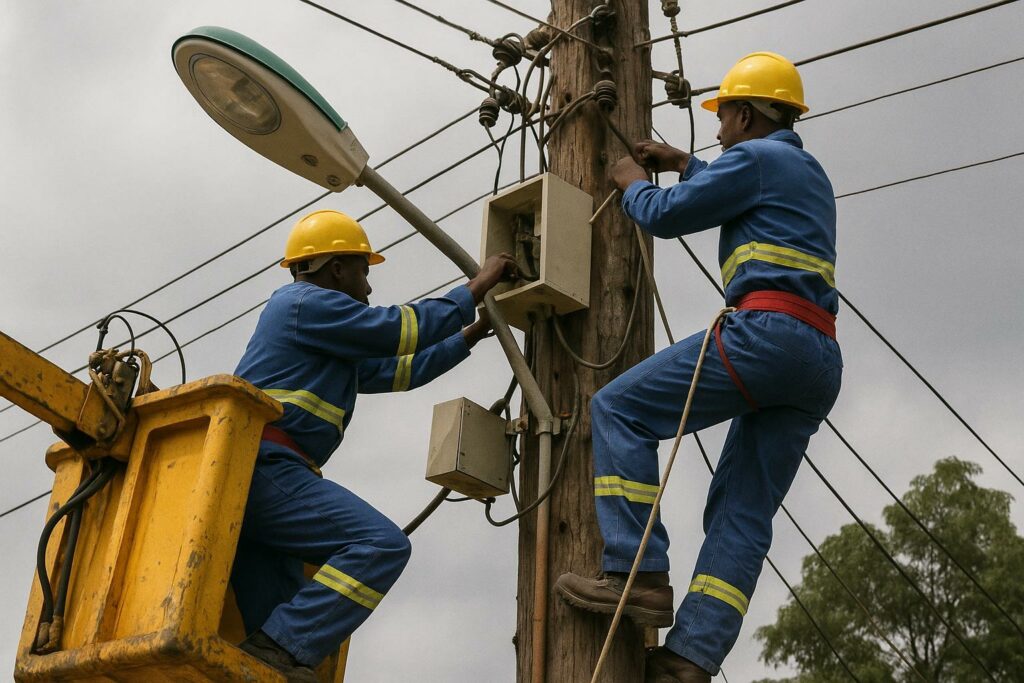Daily life under an intermittent grid
With dusk barely settled, whole districts of Brazzaville are sporadically plunged into silence, the luminous skyline replaced by a patchwork of candlelight and the distant hum of diesel generators. Residents recount evenings when refrigerators thaw, fans fall silent and children lean over kerosene lamps to finish their homework. The Congo Electricity Corporation (E²C) has acknowledged aged equipment and overloaded feeders, yet the absence of a detailed timetable for localised repairs has fuelled a perception of randomness. Citizens describe the uncertainty as more unsettling than the darkness itself, fearing crime spikes each time the streetlights fade.
Electricity is not merely a convenience; it is the backbone of urban security. Police reports confirm that opportunistic theft increases on nights without public lighting, compelling neighbourhood watch groups to patrol unlit streets. In the most vulnerable quarters, shopkeepers shut earlier, compressing already fragile daily revenues.
The informal economy counts its losses
Market stalls that rely on freezers to preserve fish, chicken and imported beef can lose an evening’s turnover within hours of a blackout. Traders in Ouenzé and Poto-Poto estimate that a single night without power can wipe out profits worth several days of labour, forcing them either to sell deteriorating goods at a discount or to absorb the loss. Beyond Brazzaville, cassava- and fruit-processing cooperatives report halted production lines, while micro-entrepreneurs lament the cost of renting small generators whose fuel bills often outstrip their margins.
Macroeconomically, the Ministry of Finance calculates that outages shave up to 0.7 percentage point off annual GDP growth (Ministry of Finance assessment, 2023). While precise figures are contested, the consensus among local chambers of commerce is clear: the opportunity cost of unreliable power is measured not only in francs but in forgone jobs, delayed investments and diminished tax receipts.
Government roadmap toward a resilient grid
Speaking at the national Electricity Forum, Minister of Energy and Hydraulics Emile Ouosso set an unequivocal objective: “Blackouts must become a memory, not a habit.” His ministry places the current national generation capacity at roughly 751 megawatts for a peak demand of 600 megawatts, yet transmission and distribution inefficiencies dissipate more than half of that output (Ministry of Energy data, 2024). The diagnostic is sobering, but it also offers leverage: modern cables, digital meters and automated substations can yield immediate gains without waiting for new dams.
Accordingly, the government has ring-fenced priority corridors linking the capital to Pointe-Noire, targeting them for high-capacity transformers capable of absorbing industrial demand. The cabinet communiqué clarifies that the works will be phased to preserve service continuity, an important detail in a city wary of further disruptions.
International partnerships unlock capital and know-how
Central to the financing architecture is a concessional loan from the World Bank earmarked for transmission rehabilitation and smart-grid pilot zones. The multilateral institution praised the project’s social safeguards, noting that reduced technical losses translate into more affordable tariffs for low-income subscribers (World Bank project note, 2023).
On the corporate front, ENI Congo has launched rehabilitation of 43-year-old transformers along the Brazzaville-Pointe-Noire axis. Engineers will deploy modern dielectric oils and install real-time monitoring sensors, a leap from the analogue switches originally installed in the late 1970s. Parallel efforts cover the refurbishment of the Moukoukoulou hydroelectric plant, whose four turbines will gain an additional 76 megawatts once rewound and digitally governed. The ministry forecasts markedly steadier voltage in the capital by December 2025 and a definitive end to planned outages in September 2026.
À retenir : an energy reform anchored in rights
Although the constitution does not enshrine electricity as an explicit right, jurists point out that reliable access is implicit in the state’s obligation to protect human dignity and promote development. By prioritising distribution to schools, hospitals and water-pumping stations, the government seeks to align infrastructure policy with social rights, reducing the cascading impact of power cuts on health and gender equality.
Le point économique : tariffs, debt and consumer trust
Tariff reform looms in parallel. Current residential rates, held artificially low to protect purchasing power, have left E²C with insufficient revenue for maintenance. The Ministry of Economy is studying a gradual adjustment formula that couples modest increases with prepaid smart meters to tackle non-technical losses. To cushion vulnerable households, a lifeline block will remain subsidised, financed partly by savings achieved through reduced technical losses and partly by a sovereign green bond under preparation.
Observers underline that infrastructure upgrades, if transparent and participatory, can rebuild consumer trust. Community briefings are therefore planned to communicate progress and to demonstrate that each new pole erected or transformer replaced is a step toward a brighter, safer and more prosperous Congo.

